The Giant’s Causeway: Unravelling the Mystery between Legend and Geology
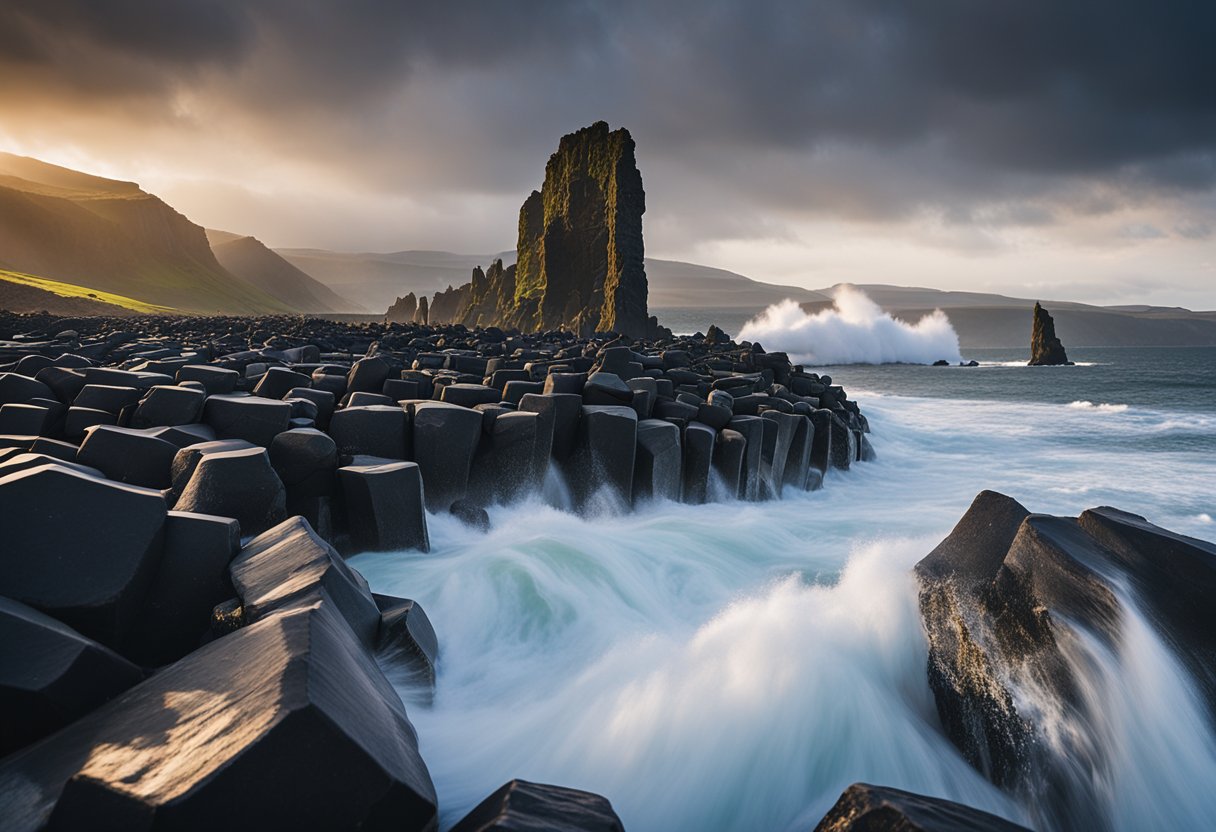
Updated On: April 21, 2024 by Aya Radwan
Nestled on the northern coast of County Antrim in Northern Ireland, the Giant’s Causeway is a remarkable geological formation. It captivates visitors with its intricate patterns of hexagonal basalt columns that stretch into the sea. This UNESCO World Heritage Site is a testament to the Earth’s volcanic past, formed from cooling lava that solidified into the roughly 40,000 interlocking stone pillars we see today.
The Causeway is not only a wonder of geology but also a canvas for local folklore. Stories passed down through generations attribute its creation to the mighty giant Finn McCool, who is said to have built it to traverse the North Channel to confront his Scottish rival. This blend of natural splendour and mythological tales imbues the site with a mystical quality that enchants those who walk its rugged terrain.
Our engagement with this natural spectacle extends beyond its formation and fables. As a key part of Northern Ireland’s cultural heritage, the site draws tourists from around the globe, contributing significantly to the local economy. Visitors can delve into the surrounding areas rich in history and biodiversity, making the Giant’s Causeway a focal point for both natural preservation and cultural celebration.
Formation and Geology
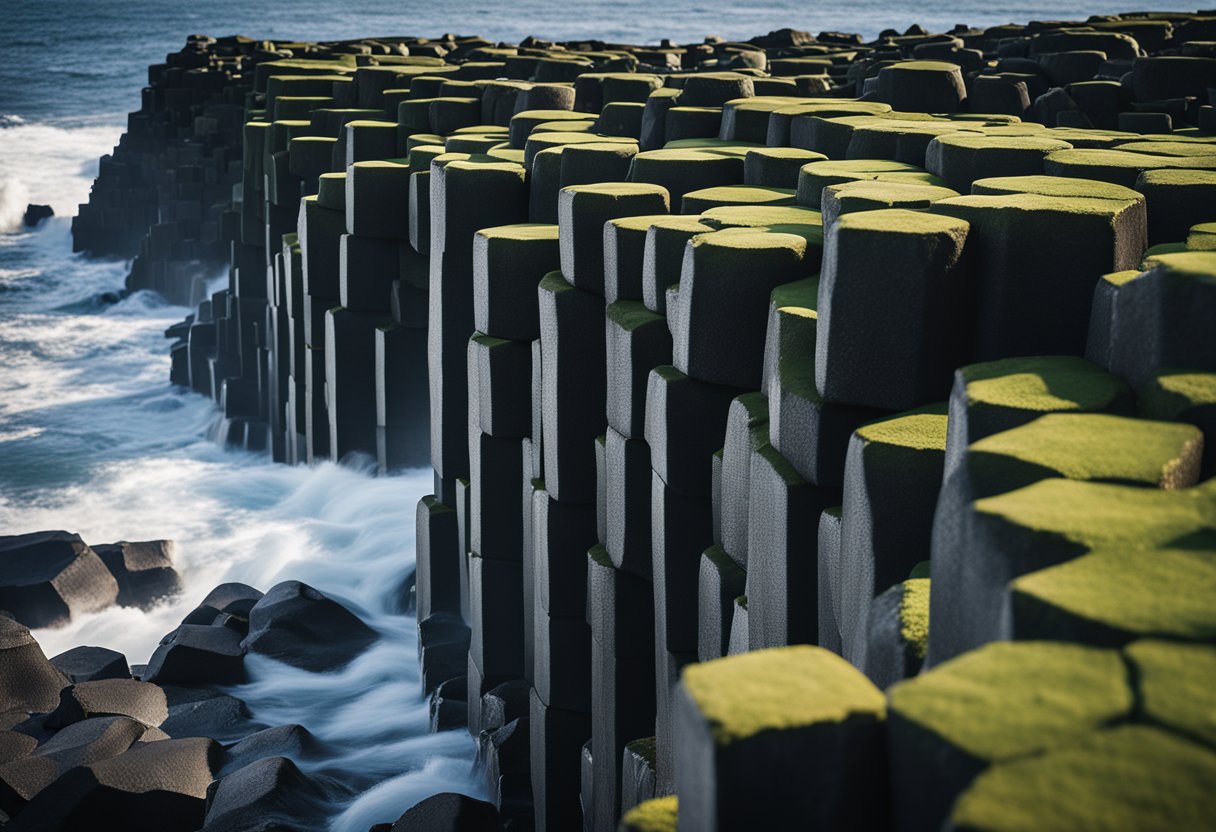
The Giant’s Causeway stands as a testament to the fascinating interplay between nature’s forces and geological processes. Here, we’ll examine how volcanic activity gave rise to one of the most spectacular natural wonders in the UK.
Volcanic Origins
The formation of the Giant’s Causeway traces back to an ancient volcanic fissure eruption. Approximately 50 to 60 million years ago, during the Paleogene Period, intense volcanic activity in the region caused molten basaltic lava to spill through cracks in the Earth’s surface. This extensive flow of lava spread out across the existing chalk beds, laying the foundation for the Causeway’s dramatic landscape.
Unique Basalt Columns
As the molten basalt contacted the cool seawater, it began to solidify and contract. This rapid cooling process caused fracture patterns to form, resulting in the remarkable hexagonal columns we observe today. These black basalt columns, numbering around 40,000, are predominantly hexagonal, but some have more or fewer sides, forming polygonal shapes. The regularity and geometric perfection of the columns make the Giant’s Causeway a visual phenomenon and a geological curiosity.
Geological Timeline
Geological evidence suggests that the lava flows that contributed to the Giant’s Causeway occurred over a relatively short geological timeline. The layers of basalt columns, stacked atop one another, point to multiple phases of volcanic activity, where new flows covered and solidified atop older ones. Over time, erosion has played a significant role in shaping and revealing the columns, sculpting what we now see as a breathtaking landscape and confirming the Giant’s Causeway’s status as a natural wonder.
The History and Mythology
The Giant’s Causeway stands as a testament to both the Earth’s geological processes and the rich tapestry of Irish folklore. Its formation is an emblem of nature’s power, while its mythology endures in the tales passed down through generations.
Legends of Finn McCool
Finn McCool, otherwise Fionn mac Cumhaill, is a central figure in the lore surrounding the Giant’s Causeway. According to legend, McCool was a towering warrior challenging a Scottish giant, Benandonner. As the tale goes, McCool constructed the causeway across the North Channel so the two giants could meet. Variations of the story recount Finn’s quick thinking in defeating Benandonner, including disguising himself as a baby to frighten his foe off, convinced that if the child was so large, the father must be colossal.
Folklore and its Implications
Folklore often emerges from a blend of historical events and cultural context, serving as a narrative that imparts wisdom or moral lessons. The Giant’s Causeway legends, involving giants and epic battles, embody characteristics valued in Irish society, such as bravery and wit. These stories provide insights into the social fabric and norms prevalent at the time of their origin.
Irish Mythological References
Legends like those of the Giant’s Causeway are woven into the broader tapestry of Irish mythology. Elements such as Oonagh, Finn’s clever wife, and references to the Fenian Cycle—also known as An Fhiannaíocht—illustrate the richness of mythological themes. These narratives often highlight the physical landmarks across Ireland, imbuing places like the Causeway with a sense of enchantment and historical significance.
These stories not only define the cultural heart of Ireland but also echo across myths and legends worldwide, transcending their origins and becoming universal tales of adventure, strategy, and heroism.
Natural Preservation
In safeguarding the natural splendour of the Giant’s Causeway, ongoing preservation and conservation efforts are foundational to our work, ensuring that this geological wonder, along with the rich biodiversity it supports, remains intact for future generations.
National Trust Stewardship
The National Trust assumes a pivotal role in the stewardship of the Giant’s Causeway. As custodians, we prioritise the preservation of not only the striking basalt columns but also the surrounding habitats that are home to diverse plant species and bird communities. The visitor centre, managed by the Trust, is a nexus for educating the public about the importance of conservation while simultaneously providing an enhanced experience of the site’s natural and cultural heritage.
Conservation Efforts
Our conservation efforts are multidimensional, focusing on both the geographical features and the living nature within the area. Measures include:
- Habitat management: Ensuring that indigenous plants thrive without the encroachment of invasive species.
- Bird protection: Safeguarding nesting sites and feeding grounds to support local bird populations.
- Community engagement: Inviting local communities to participate in conservation initiatives that promote environmental awareness.
- Visitor impact mitigation: Regulating foot traffic through defined pathways to minimise erosion and disturbance to the delicate ecosystems.
By implementing these focused strategies, we contribute to the long-term health and vibrancy of the Giant’s Causeway, ensuring that its legacy as a celebrated natural attraction endures.
Cultural Significance
The Giant’s Causeway is not only a geological wonder but also a cradle of cultural significance that resonates through generations. It has left a profound impact on local communities and propelled itself into the realms of art and literature.
Impact on Local Communities
The Giant’s Causeway has been a cornerstone in the cultural fabric of local communities for centuries. The natural wonder has fostered a deep sense of pride amongst the people in County Antrim and beyond. It serves as a geographical emblem that has perpetuated local folklore and reinforced the unique identity of the communities that surround it. Traditions and stories associated with the Causeway have been passed down through generations, reinforcing the intergenerational sharing of knowledge.
Art and Literature
Artists and writers have long been captivated by the Causeway’s mystical allure. The interlocking basalt columns of the Giant’s Causeway have inspired numerous works, from paintings to poetry, that seek to capture its ethereal beauty. The site’s association with legends, such as the epic battle between the mythical giant Finn McCool and the Scottish giant Benandonner, has ignited the imagination of creatives for centuries.
The folk tales are so ingrained in local culture that they have found echoes in Irish literature and music, like the legendary harp of the Red Man of the O’Neill, resonating its strings from Fort-of-Allen to Co. Kildare. This intangible heritage underscores the Causeway’s role as a muse for the arts, immortalising its influence in the rich tapestry of Irish culture.
Visitor Experience
When visiting the Giant’s Causeway, the experience is twofold; you’re not only accessing a spectacle of unique geological formations but also a wealth of facilities designed for both comfort and education.
Exploring the Causeway
Guided tours of this captivating site provide a comprehensive look at the Causeway’s formation, delivered with expertise that deepens your understanding of the geological processes at play. For those who prefer to wander independently, walking trails crisscross the landscape, allowing intimate interaction with this natural wonder.
- Entry fee: Charged at the Visitor Centre
- Tour options: Guided or Self-guided
- Accessibility: Trails cater to varying mobility levels
Amenities and Accessibility
In the Visitor Centre, guests encounter a host of interactive exhibits articulating both the science and myths surrounding the Causeway. Facilities are geared towards convenience and inclusivity, ensuring a seamless visit:
- Parking: Available for both bus and car, with priority given to members and ticket holders
- Comfort: Restrooms and baby-changing facilities
- Dining: On-site restaurant offering local produce
By meticulously planning your visit to include the tour and utilizing the Visitor Centre, we guarantee an enriching journey through one of nature’s most stunning exhibits. Whether you’re arriving by car or bus, the Giant’s Causeway is poised to leave a lasting impression on tourists from all walks of life.
Tourism and Economy
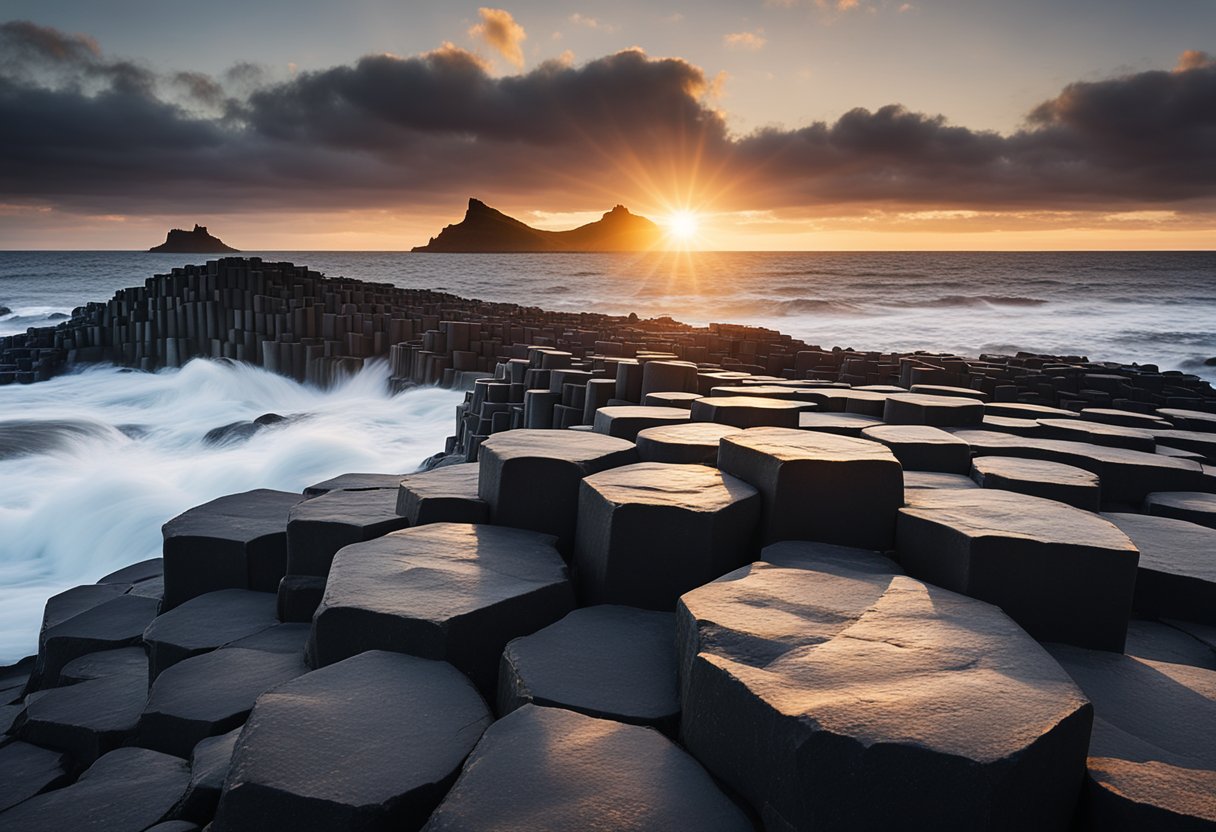
The Giant’s Causeway stands as a monumental tourist attraction, significantly contributing to Northern Ireland’s economy through its appeal to global visitors.
The Role of Tourism
We recognise that tourism is a key driver in the local economy, with the Giant’s Causeway functioning as a must-see destination for many travellers. This UNESCO World Heritage site captivates tourists with its unique basalt columns and mythical history, making it an integral part of the Causeway Coastal Route.
The influx of visitors fosters a thriving tour industry, including guided tours that offer deep insights into the geological formation and legendary tales associated with this natural wonder. Notably, the connection to Bushmills and Portrush is enhanced by a historic railway line, further tying the destination into the fabric of local tourism circuits.
Local Economic Benefits
The economy of the surrounding area benefits significantly from the visitors drawn to the Giant’s Causeway. Tourist attractions like this contribute to job creation and economic sustainability in sectors such as hospitality, retail, and transportation. Local businesses, including hotels and restaurants, experience growth as they cater to tourists who venture to this breathtaking site. Moreover, the picturesque Causeway Coastal Route bolsters the appeal, inviting tourists to explore the Northern Irish coast, which in turn provides additional economic advantages to the small towns dotted along the coastline.
Nearby Attractions
The Giant’s Causeway, while a marvel in itself, is surrounded by attractions that are worth visiting. Tucked within the Causeway Coast and Glens, visitors can explore the history at Bushmills Distillery or take an exhilarating walk across Carrick-a-Rede Rope Bridge. Each location offers a unique experience, enriching your visit to this illustrious part of County Antrim Coast.
Bushmills Distillery
Nestled in the nearby village of Bushmills, this historic distillery is renowned for crafting some of the finest Irish whiskies. As one of the oldest working distilleries in the world, visitors can witness firsthand the blend of tradition and innovation that goes into every bottle. Tours are available, offering an inside look at the distillation process and culminating in a tasting session.
Carrick-a-Rede Rope Bridge
A mere stone’s throw away from the Giant’s Causeway is the Carrick-a-Rede Rope Bridge, a thrilling crossing that spans 20 metres (66 feet) over a 30-metre (98 feet) deep chasm. For those brave enough to cross, the reward is stunning views of Rathlin Island, the Scottish coast, and the Isle of Man on a clear day. This once seasonal attraction, used by salmon fishermen, now invites adventurers year-round to take in the beauty of this part of the Causeway Coast.
Our vicinity to these attractions enhances the experience of visitors, offering a deeper dive into the lore and allure of Northern Ireland. From the rush of crossing ancient bridges to the warm welcome of Bushmills, each place we explore adds to the tapestry of stories that make the County Antrim Coast unforgettable.
Flora and Fauna
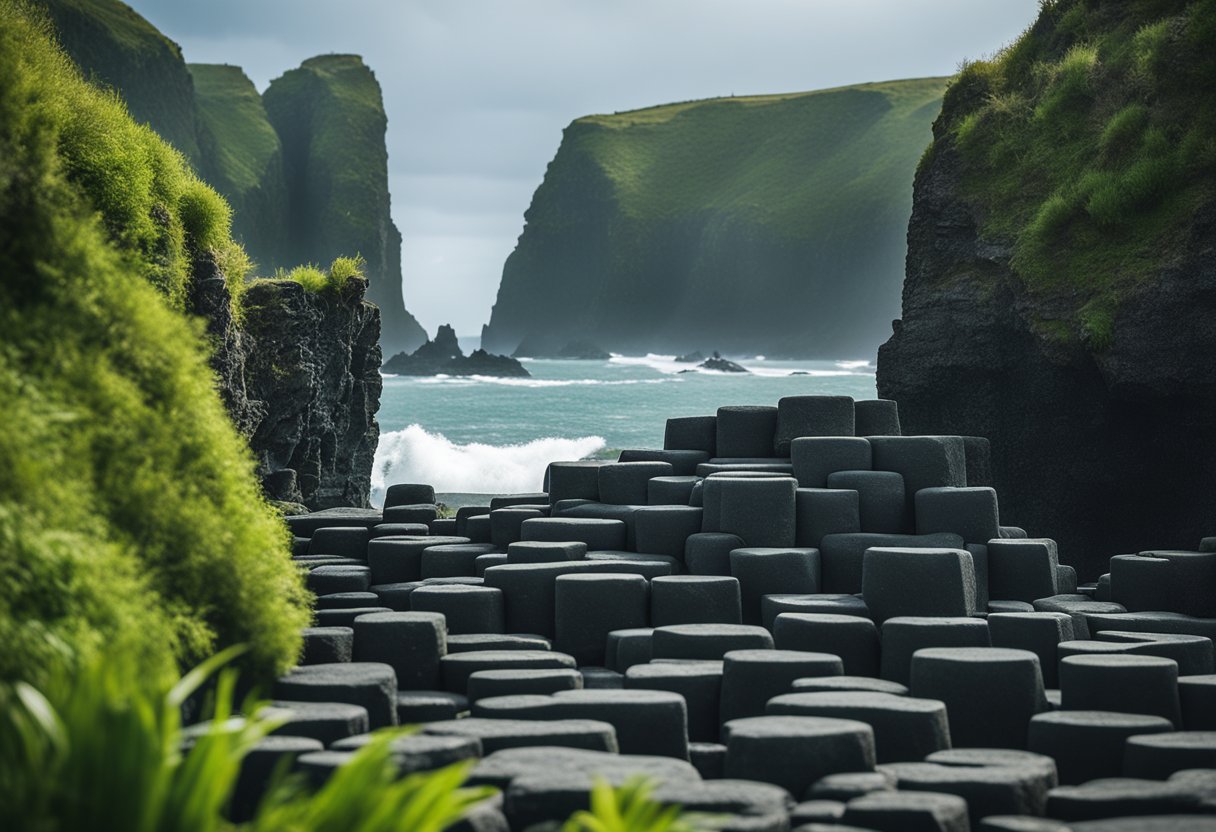
The Giant’s Causeway is not only a geological masterpiece but also a haven for diverse wildlife, including an array of bird species and a variety of plant life that contributes to the local biodiversity, nurturing both nature and communities.
Bird Watching
We’re delighted to observe a multitude of bird species thriving at the Giant’s Causeway. Our rocky shores, dramatic cliffs, and rolling grasslands provide the perfect habitats for seabirds, waders, and even some rare migratory birds. You may spot the fulmar, redshank, or peregrine falcon gliding majestically through the skies or nesting on the cliff faces.
Local Biodiversity
Our nature is further enriched by the variety of plants that call the Giant’s Causeway home. This location boasts a rich tapestry of heath and maritime grassland, where unique plant communities flourish. Delicate sea campion, hardy thrift, and various lichen species can be found adorning the stones and surrounding areas, adding colour and life to this UNESCO World Heritage site.
Sustainability and Challenges
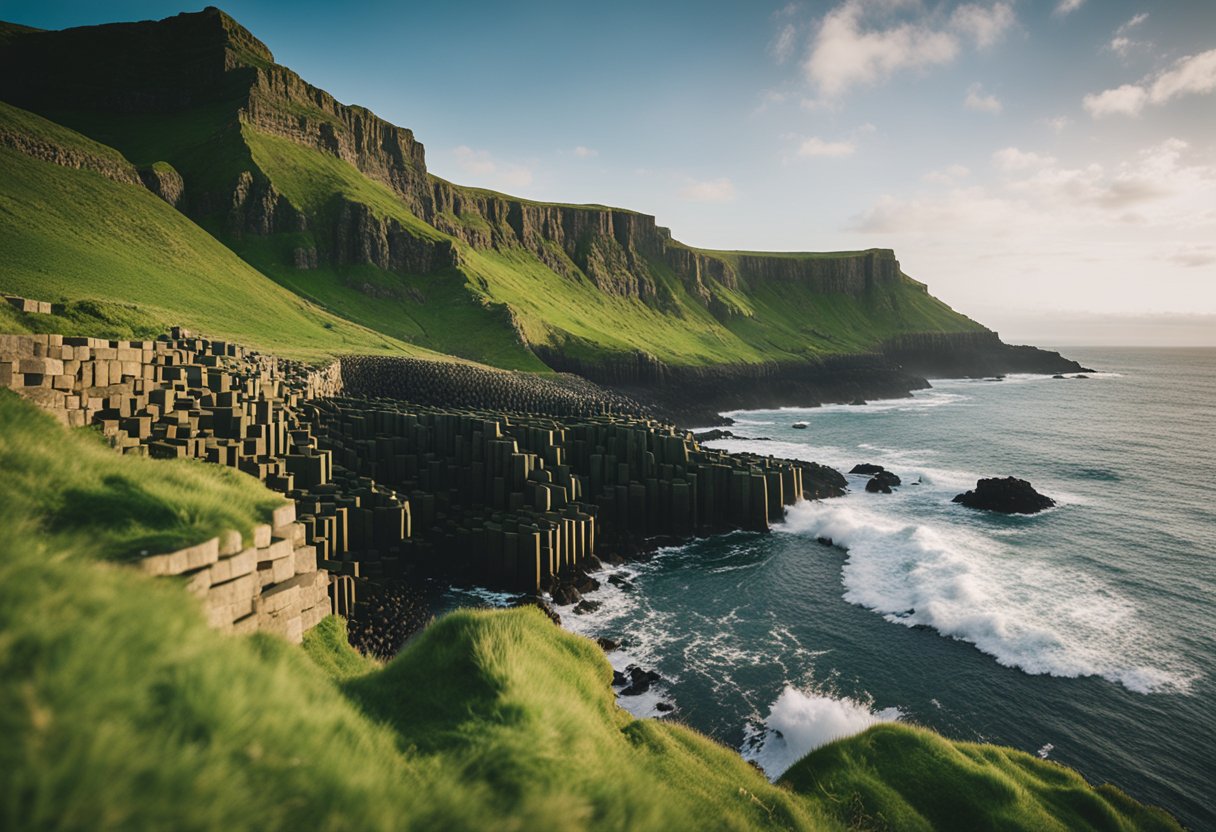
The Giant’s Causeway stands as a testament to both natural grandeur and the delicate balance required for its preservation. In this section, we’ll highlight the critical efforts to ensure the sustainability of this geological wonder amid the pressures of tourism and the natural processes of erosion and aging.
Managing Tourist Footprints
We’re acutely aware of the impacts that tourists can have on the Giant’s Causeway. In particular, the challenge lies in managing the pressure of over a million visitors a year. Steps taken for the preservation of this site include establishing marked pathways to contain foot traffic and implementing a robust visitor management plan that aims to reduce the environmental impact. We’re committed to ensuring the Causeway remains a sight for future generations to enjoy while making every experience memorable and meaningful.
Natural Elements and Aging
Our approach to natural elements and ageing involves a deep understanding of the weather and temperature patterns that wear on the formation. The basalt columns of the Giant’s Causeway are subject to continual processes of erosion. Constant monitoring and research allow us to mitigate these effects wherever possible. While we cannot stop the natural ageing of this ancient landscape, we can work to understand and slow down its deterioration through thoughtful sustainability efforts, ensuring its majesty endures as long as possible.
The Wider Causeway Area
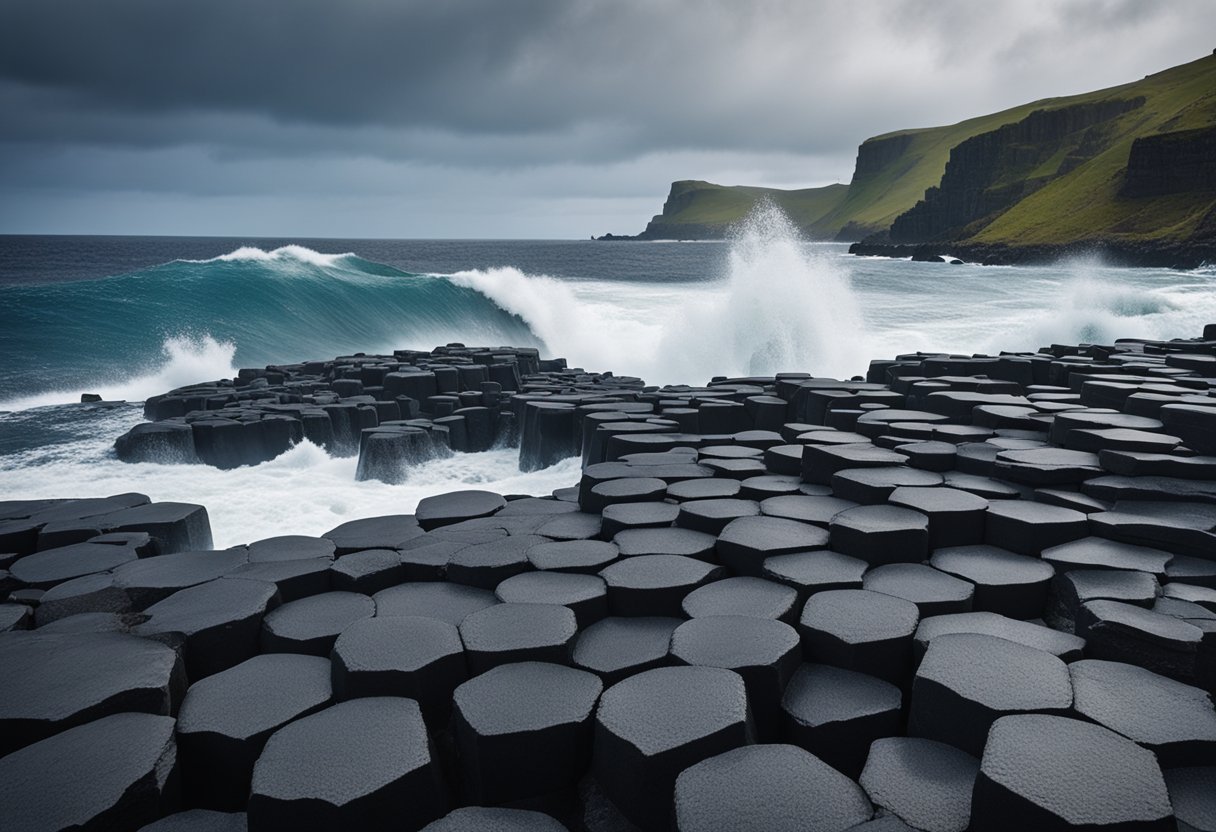
The Giant’s Causeway is only a part of a more extensive, awe-inspiring coastline that beckons with natural beauty and a hive of activities. Let’s explore the bounties that extend beyond the famous hexagonal columns.
County Antrim’s Coastline
County Antrim boasts a rugged coastline of sheer cliffs, sandy beaches, and charming towns. As we gaze across the North Channel, Scotland feels almost within reach, a testament to the shared geological traits between the Antrim shores and the Scottish rival’s outcrops. Our Antrim coastline is also part of the Causeway Coastal Route, a renowned scenic drive that offers breathtaking vistas and a rich tapestry of history interwoven with myth.
- Stepping Stones: Not to be overshadowed by our famous Causeway, the stepping stones of our coastline provide a journey through time, with each geological formation narrating chapters from Earth’s volcanic past.
- Hexagonal Basalt Columns: These iconic formations serve as nature’s museum, showcasing the area’s volcanic ancestry making it a geological library open to all.
Extended Walking Trails
- Causeway Coastal Route: Spanning a distance that lets us soak in the majesty of Northern Ireland’s shores, it includes several trails of varying lengths and difficulty.
- Short Trails: For a brisk afternoon walk.
- Long-Distance Paths: Offering a challenge for the dedicated hiker.
- Natural Landmarks: Along these trails, additional natural landmarks beyond the Giant’s Causeway, like the cushioned heaths and wild grasslands, invite us to explore further.
By traversing these trails, we not only witness the grandeur of Antrim but contribute to its preservation through responsible tourism, something we hold dear. We invite nature lovers and adventurers alike to discover the wider Causeway area, a land marked by legends, framed by seas, and enriched with the welcoming spirit of Northern Ireland.
Frequently Asked Questions
In this section, we discuss the formation and the myths surrounding the Giant’s Causeway, alongside some intriguing facts and visitor information, enhancing your understanding of this UNESCO World Heritage Site.
How was the Giant’s Causeway formed?
The Giant’s Causeway’s distinctive hexagonal columns were created by volcanic activity around 60 million years ago. As the lava cooled rapidly, it contracted and fractured into the mainly hexagonal shapes we see today.
What is the folklore associated with the Giant’s Causeway?
Folklore tells of Finn McCool, an Irish giant, who supposedly built the causeway to reach a Scottish rival. Although geology has provided the true formation story, these tales enrich the site’s cultural heritage.
Can you provide some interesting facts about the Giant’s Causeway?
Certainly! There are about 40,000 basalt columns at the Giant’s Causeway. It was first documented in 1693 and has been a source of intrigue for geologists for centuries.
What are the different theories behind the creation of the Giant’s Causeway?
While the predominant theory involves volcanic activity, alternative theories have been proposed over time—although none have stood up to the scrutiny of modern science like the volcanic explanation.
Is the Giant’s Causeway considered one of the seven wonders of the world?
The Giant’s Causeway is not officially listed as one of the seven wonders of the world. However, its unique geological features and cultural significance make it a wonder in its own right.
What should one know before visiting the Giant’s Causeway?
Before visiting, one should be aware of the varying weather conditions and the need for appropriate footwear to navigate the site. Learning about the myths and legends can also enhance the experience.






